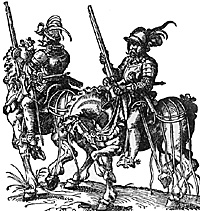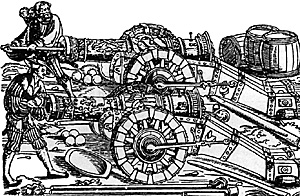 Renaissance German medium armoured cavalry after a woodcut from Jost Amman's Künstbuchlin, 1599.
Renaissance German medium armoured cavalry after a woodcut from Jost Amman's Künstbuchlin, 1599.
The Renaissance means different things to different audiences. Historians generally accept the Renaissance as that period in (western) European history between the mid-fifteenth and mid-sixteenth centuries. Militar y historians tend to consider it the period between the outbreak of the Italian Wars in 1494 and the end of the Thirty Years Wear in 1648. The wargaming fraternity (the societies/clubs, rules and army lists, gaming magazines and players) has the broadest definition of the period, seeing it as commencing with the Italian Wars and closing around 1700, or even later.
For wargamers, the term "Renaissance" is essentially a convenient description for the period between the end of the Middle Ages and the rise of standing regular armies and the large scale warfare of the Malburian era. It was the period in which the use of bows and crossbows declined, while, conversely, the use of firearms (arquebuses then muskets) became increasingly widespread.
The pike had a dramatic, albeit brief dominance of the battlefield before falling into a long decline. It was also the period in which fighting men were increasingly organised into units. The common features of the period from start to finish are pike and shot (firearms) and these are what allow wargaming of the sixteenth and seventeenth centuries to be defined as Renaissance wargaming despite the fact that warfare changed significantly over these two centuries, and therein lies the problem.
At Cancon 99 eight of the nine armies involved in the DBR Competition dated from 1644 or later. Only one could be dated within the historical Renaissance. It was a similar story at Cancon 98. These experiences are no different to those at other competitions. Players want to win (or to put in a very respectable performance) so they chose the best army they can find. In the case of Renaissance wargaming the best competition armies are more likely to be those from the mid to late seventeenth century, particularly those with a higher proportion of musket-armed shot.
While later period armies are theoretically pike and shot armies, the proportion of shot, especially musket-armed shot is significant. The requirement to field pikemen in these armies can be so limited as to be token. The advances in weaponry, organisation and tactics over the sixteenth and seventeenth centuries mean that later period armies are both vastly different from and vastly superior to those of the early period. So much so that good generalship and favourable dice are not usually enough to give an early period army victory over a later period opponent.
I should point out here that while I prefer to wargame the historical Renaissance, I don't mind wargaming with later period armies. The difficulty for me is the idea of fielding an early period army against a later period opponent and expecting to get anywhere.
 16th Century Renaissance artillery after a contemporary woodcut by Schoen.
16th Century Renaissance artillery after a contemporary woodcut by Schoen.
Essentially, the two are so different that a victory with a later period army tells the player more about the relative strength of the army list he chose rather than the merits of his generalship. I know there are several other Renaissance wargamers around that don't bother entering competitions because they prefer to play with a sixteenth century army, but see little point or enjoyment in spending a weekend being repeatedly defeated. This is no slight on any particular competition or organiser, just an issue that needs some thought.
So what is the solution? Perhaps it is time for a new approach to Renaissance wargaming that involves dividing the period into two separate eras: that of the Renaissance (from 1494 to say 1600) and that of the Age of Absolutism (1600-1700). This would allow for wargaming between historical contemporaries or near contemporaries, producing more even handed battles and realistic outcomes. Of course there would still be weaker armies, particularly among the non-European lists, but if they are contemporary antagonists the battle will be realistic if not entirely historically accurate.
I have even heard it suggested that, as an experiment, it might be worth trying to put together two "Renaissance" competitions at one of the conventions.
Interestingly, in 1982 the authors of Newbury Rules Constantinople to Vienna Renaissance wargaming rules made the following point: "We ... recommend that players should be encouraged to field chronologically compatible armies, and with that in mind competition organisers should select one or at most two consecutive sub-periods for that competition with penalties for players fielding armies out of that period."
No doubt the views I have expressed here will provoke debate. I also have a number of ideas about army lists and rules that I may go into in a later issue, the Editor permitting. At this stage I am simply seeking to raise the issue. Is a competition dominated by mid to late seventeenth century armies with a majority of musket-armed shot really Renaissance wargaming or just conveniently described that way?
Thanks Richard, the editor permits! We'll look forward to more on Renaissance gaming in future issues - Ed.
Response: Renaissance or Fantasy? (#7)
Back to Table of Contents -- Kriegspieler #5
To Kriegspieler List of Issues
To MagWeb Master Magazine List
© Copyright 1999 by Kriegspieler Publications.
This article appears in MagWeb (Magazine Web) on the Internet World Wide Web.
Other military history articles and gaming articles are available at http://www.magweb.com